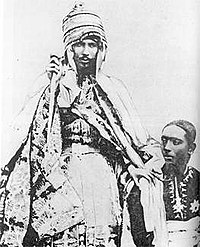Yohannes IV
Yohannes IV. (Also John IV. , Ethiop . ዮሐንስ ፬ኛ ; actually Kassa , in Tigrinya Kahsay ), completely Dajazmach Kassa Sebagadis (* 1831 ; † March 10, 1889 in Metemma or Gallabat on the border with Sudan ) was Prince of Tigray and from 1872 to 1889 Emperor of Ethiopia .
Life
Yohannes IV. Was the successor of Tekle Giyorgis II. , Whom he had decisively defeated on July 11, 1871 in the battle of Assam (near Adua ) and since then kept in captivity. On January 21, 1872 he was crowned king in Aksum . Like his predecessor, he was able to unite rule over all Ethiopian provinces in his hand.
Unlike his predecessor Theodor II , Yohannes was more conciliatory in terms of domestic politics, as can be seen in the dealings with Ras Adal and Ras Menelik (later Emperor Menelik II ), who were not deposed after their submission, but had to pay tribute. This behavior was in stark contrast to the actions of his predecessor Theodor II , who made so many enemies.
During their punitive expedition to Ethiopia in 1868, Yohannes IV had supported the British and was rewarded by them with weapons and ammunition. In 1875 and 1876 he had fended off Egyptian invasions, but then undertook to help the Egyptians evacuate their garrisons on the Sudanese-Ethiopian border during the Mahdi uprising in Sudan . Fighting with the Mahdists had therefore already broken out in 1885. In 1887 the Mahdists triumphed at Debra Sin and were able to take and plunder Gonder .
Yohannes IV made the Mahdist caliph Abdallahi ibn Muhammad an offer of peace, which was rejected. The emperor then announced that he would move against Khartoum . In March 1889, the Ethiopians attacked Sudan under the leadership of the emperor. On March 9th, the Battle of Gallabat (also known as the Battle of Metemma ) took place. It seemed as if the Mahdists had already lost the battle when the Kaiser was fatally struck by a sniper . On his deathbed, Yohannes named his son Mengesha Yohannes as his successor. The Ethiopian troops then withdrew. On March 11th, the Mahdists went into pursuit and the Ethiopians were driven to flight in a second battle on the Atbara River . The Mahdists succeeded in stealing the body of Yohannes IV and taking it with them to their capital, Omdurman . There his head was displayed on a lance.
Personal
Yohannes is described by Gerhard Rohlfs as a deeply religious ruler. Rohlfs, who visited him in 1880/1881 on behalf of the German Emperor Wilhelm I in Debre Tabor , accompanied by Anton Stecker , describes him relentlessly in religious matters and convinced of his mission of fighting the Muslims. In 1880, Yohannes issued an order that all Muslims in his domain either converted to Christianity or had to emigrate. Rohlfs notes that the residents - formerly known to him as Muslim places - were now all Christian. This was easy to see, as it was the custom of Christian Abyssinians to wear a blue ribbon around their necks.
Yohannes also boasts in the audience: "Now I only have Christians and a few Falascha in Abyssinia".
Rohlfs avoided addressing religious issues in the audience, although the emperor kept taking up the subject. Rohlfs remarks: “Only recently had the emperor had a big dispute with Bishop Massaya, who was soon after expelled from Abyssinia, and other clergy from Shewa , which ended with the indigenous clergy, who had become Catholic and the unity in the nature of Christ take it differently, cut off the tongue ”.
Elsewhere Rohlfs remarks: “Is it possible to argue with a priest at all? And the current Emperor of Abyssinia (Yohannes) is such a priest, the summus episcopus , he knows the Bible like no other ... "
As a personal gift from Rohlfs, the emperor was given a sword from Solingen, originally intended for the Sultan of Uadai. The present from the German emperor was a large, valuable umbrella made by Gerson in Berlin, with rich embroidery, gold arabesques and gold fringes with a diameter of two meters. In Abyssinia, umbrellas were a symbol of the princes. Yohannes felt particularly honored by this gift. It can be assumed that Rohlfs, with his particular knowledge of Abyssinia, helped choose the gift. In return, Rohlfs also received valuable gifts.
literature
- Wilhelm Baum: John IV (Yohannes), Emperor of Ethiopia. In: Biographisch-Bibliographisches Kirchenlexikon (BBKL). Volume 20, Bautz, Nordhausen 2002, ISBN 3-88309-091-3 , Sp. 817-821.
- H. Pleticha: The Mahdi uprising in eyewitness accounts. dtv, Munich 1981, ISBN 3-423-02710-X .
- Gerhard Rohlfs: My mission to Abyssinia - undertaken on the orders of Sr. Maj. The German Emperor in the winter of 1880/81. FA Brockhaus, Leipzig 1883.
- Zewde Gabre-Selassie : Yohannes IV of Ethiopia: A political biography. Oxford 1975, ISBN 0-19-821695-5 .
Individual evidence
- ↑ Deutsches Historisches Museum: Chronicle 1872 , accessed on January 12, 2011.
- ^ Gerhard Rohlfs: My mission to Abyssinia - undertaken on the orders of Sr. Maj. The German Emperor in the winter of 1880/81. FA Brockhaus, Leipzig 1883, p. 216.
- ^ Gerhard Rohlfs: My mission to Abyssinia - undertaken on the orders of Sr. Maj. The German Emperor in the winter of 1880/81. FA Brockhaus, Leipzig 1883, p. 216.
- ^ Gerhard Rohlfs: My mission to Abyssinia - undertaken on the orders of Sr. Maj. The German Emperor in the winter of 1880/81. FA Brockhaus, Leipzig 1883, p. 222.
| predecessor | Office | successor |
|---|---|---|
| Tekle Giyorgis II. |
Emperor of Ethiopia 1872–1889 |
Menelik II |
| personal data | |
|---|---|
| SURNAME | Yohannes IV |
| ALTERNATIVE NAMES | Cash desk; John IV |
| BRIEF DESCRIPTION | Emperor of Ethiopia (1871–1889) |
| DATE OF BIRTH | 1831 |
| DATE OF DEATH | March 10, 1889 |
| Place of death | Metemma , Sudan |


